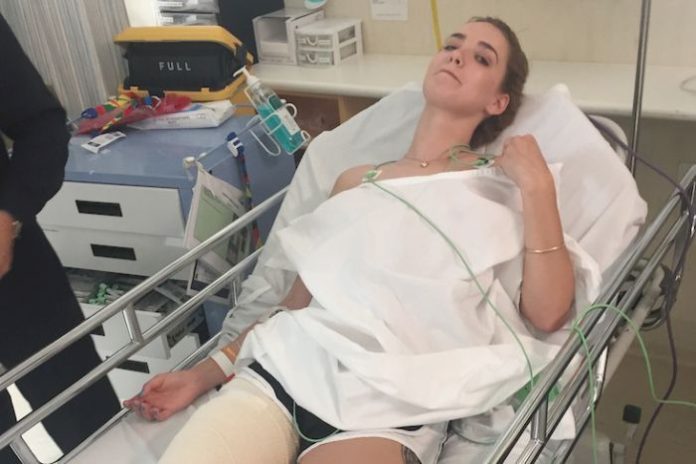
A Perth woman who was bitten by a tiger snake has questioned why she was not given anti-venom after suffering a rare delayed reaction to the wound.
Jorji Harper, 20, was bitten on the leg at Yellagonga Regional Park in the northern Perth suburb of Kingsley last month.

Ms Harper, who is training to be a teacher, was at the park to work on a proposal for a school excursion.
“We think we accidentally cornered a tiger snake against one of the historical plaques and I think I was closest to it,” she said.
“Everyone else sort of screamed ‘Snake!’, jumped backwards, I didn’t jump back as fast as I could’ve. I’d jumped towards the fence instead and had to run around, but by then it’d already bitten me twice.”
After the culprit was identified as a tiger snake, a tourniquet was applied to Ms Harper’s leg and an ambulance was called.
But Ms Harper said after arriving at Joondalup Health Campus, the medical staff did not give her anti-venom.
“There was venom in my blood, but not enough, so they said I didn’t need anti-venom,” she said.
“Because they said they called up the people who were specialised in this, and they said ‘no, it’s not enough to be given any anti-venom’, so they didn’t give me any.”
Her leg was kept wrapped in a splint for an overnight stay, and she was released from hospital the following day.
‘It just kept getting worse’
It was in the days that followed that Ms Harper suffered a delayed reaction to the snake bite.
Her ankle became swollen, her pain worsened and she was in and out of Fiona Stanley Hospital for treatment.
“I was a bit confused. I thought the muscle pain would go away, like if you were going to work out and it goes away in a few days, and it just kept getting worse, I kept getting weaker,” she said.
“I wasn’t able to get out of bed myself or lift my head up or move my arms above a certain height.”
Ms Harper’s kidneys were affected and she was losing muscle mass. She couldn’t go to work and found it hard to return to studies.
“Apparently my age, height, weight, it all sort of [combined],” she said.
“I was fighting it off as hard as I could and then it kicked in later.”
Delayed reactions not common, hospital says
Anti-venom is only used in the first 12 hours after a bite, when it is clear a snake has injected its venom into a victim.
The director of medical services at Joondalup Health Campus, Simon Wood, said there was a risk associated with unnecessary use of anti-venoms, due to possible allergic reactions.

While he was unwilling to comment on the specifics of Ms Harper’s case, Dr Wood said delayed reactions from snake bites were described in medical literature.
“They’re not common, [but] the initial approach to the patient nevertheless would be the same,” he said.
“An initial assessment in the emergency department, usually while they have the first aid measures in place, [we] look and see if there’s any clinical evidence of envenomation, so we look at a neurological examination and blood tests.”
Dr Wood said patients were discharged if those examinations and subsequent blood tests failed to raise concerns, with subsequent delayed reactions difficult to predict.
“The only way to know if there was a delayed reaction was the progression of time, but the incidence of that is quite rare,” he said.
“That’s the recommendation of all of the toxicology experts that I know of in Australia – if there’s not signs of envenomation requiring anti-venom within those 12 hours, then it’s very unlikely that there’s going to be any significant envenomation that requires treatment.
“[Delayed reactions are] very rare, so rare that it’s difficult to get the data on those to give us any clear understanding why it might happen.”
Ms Harper is still undergoing tests and has agreed to be used as a case study.
